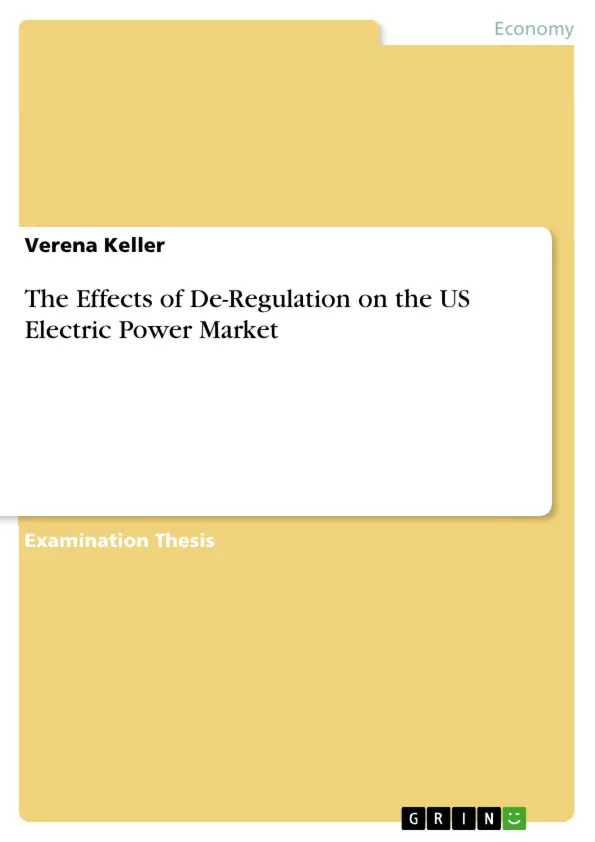Thomas Edison and Joseph Wilson Swan revolutionized the use of electricity by inventing the light bulb in 1879 (cf. Center for Solid State Science). With this new invention people finally had the possibility to light their homes and streets at night. Obviously this entailed a wide range of advantages in terms of the standard of economy, security, comfort and much more. However, with the invention and spread of the light bulb another problem occurred simultaneously: the need for nationwide electric power supply. Due to the lack of devices, there had been no need to supply power on the large scale before the invention of the light bulb. Now a solution for providing the populace with electric power had to be found. It was again Edison, who therefore laid the foundation, three years after he had in-vented the “artificial light”. Simultaneously he intended, as can be deducted from the quotation above, that electricity became available and affordable for every-one.
Inhaltsverzeichnis (Table of Contents)
- INTRODUCTION
- CONTEXT AND MOTIVATION
- PLAN OF THE WORK
- THE ELECTRIC POWER MARKET
- ELECTRIC POWER
- AN HISTORICAL OVERVIEW AND DESCRIPTION OF THE ELECTRIC POWER MARKET
- NATURAL MONOPOLY MARKETS
- Theory of Natural Monopoly
- The US Electric Power Market - A Natural Monopoly
- ECONOMIC REGULATION
- HISTORICAL OVERVIEW OF ECONOMIC REGULATION
- THE REGULATORY PROCESS
- THEORY OF REGULATION
- Normative Analysis as a Positive Theory
- Capture Theory
- Economic Theory of Regulation
- Does Empiricism support the Theories of Regulation?
- NATURAL MONOPOLY REGULATIONS AND THE ELECTRIC POWER MARKET
- TRADITIONAL RATE-OF-RETURN REGULATION
- AVERCH - JOHNSON EFFECT
- PEAK-LOAD PRICING MODEL
- RAMSEY - BOITEUX PRICING
- CHANGES IN THE ELECTRIC POWER MARKET
- CRITIQUE OF THE NATURAL MONOPOLY
- DEGENERATION OF THE NATURAL MONOPOLY'S RELEVANCE FOR THE ELECTRIC POWER INDUSTRY
- THE EFFECTS OF TECHNOLOGICAL DEVELOPMENT ON THE RETAIL REGULATION
- Digital Communication
- Transmission
- THE DE-REGULATION PROCESS
- POLITICAL CHANGES FAVORING THE DE-REGULATION PROCESS
- THE CONCEPT AND IMPLEMENTATION OF DE-REGULATION
- MARKET MONITORING
- EMPIRICISM FAVORING DE-REGULATION
- CALIFORNIA'S DE-REGULATION
- CALIFORNIA'S MOTIVATION FOR A RESTRUCTURING OF THE MARKET
- THE CONCEPT AND IMPLEMENTATION OF THE DE-REGULATION
- NEW INSTITUTIONS FOR THE RE-STRUCTURED MARKET
- THE COLLAPSE
- The electricity crisis
- The financial crisis
- THE SUBSIDENCE OF THE CRISIS AND THE "LIFE AFTER"
- THE CONSEQUENCES FOR THE WHOLE COUNTRY
Zielsetzung und Themenschwerpunkte (Objectives and Key Themes)
This work investigates the effects of deregulation on the US electric power market, focusing on the transition from a regulated natural monopoly to a competitive market structure. The author aims to analyze the theoretical basis for regulation and deregulation, explore the historical development of the US electric power market, and examine the impact of deregulation on market performance.- The transition from a regulated natural monopoly to a competitive market structure in the US electric power market.
- The theoretical and historical context of regulation and deregulation in the electric power industry.
- The impact of deregulation on market efficiency, consumer welfare, and industry structure.
- The role of technological advancements in shaping the deregulation process.
- The case study of California's deregulation experience, highlighting both successes and failures.
Zusammenfassung der Kapitel (Chapter Summaries)
- Introduction: This chapter introduces the context and motivation for the study, outlining the historical development of the US electric power market and the shift towards deregulation. The author also presents the plan for the work, outlining the key themes and chapters to be covered.
- The Electric Power Market: This chapter provides an overview of the electric power market, exploring the characteristics of electricity as a commodity and the historical development of the industry. It examines the concept of natural monopoly markets and its relevance to the US electric power market.
- Economic Regulation: This chapter delves into the theory and practice of economic regulation, examining the historical overview, the regulatory process, and different theoretical perspectives on regulation, including normative analysis, capture theory, and the economic theory of regulation. It also assesses the empirical evidence supporting these theories.
- Natural Monopoly Regulations and the Electric Power Market: This chapter focuses on traditional rate-of-return regulation and its application to the electric power industry. It explores the Averch-Johnson effect, the peak-load pricing model, and the Ramsey-Boiteux pricing approach to regulation.
- Changes in the Electric Power Market: This chapter examines the critiques of the natural monopoly model, the evolving relevance of this concept to the electric power industry, and the impact of technological advancements, particularly digital communication and transmission, on the retail regulation.
- The De-regulation Process: This chapter explores the political and economic factors driving the deregulation process in the US electric power market. It examines the concept and implementation of deregulation, the role of market monitoring institutions, and the empirical evidence supporting deregulation.
- California's De-regulation: This chapter focuses on the case study of California's deregulation experience, analyzing the motivation behind the restructuring of the market, the concept and implementation of deregulation, the creation of new institutions, and the subsequent collapse of the market. It investigates the causes of the electricity crisis, the financial crisis, and the consequences of the deregulation process for the entire country.
Schlüsselwörter (Keywords)
The key themes and concepts explored in this work include the US electric power market, deregulation, natural monopoly, economic regulation, rate-of-return regulation, peak-load pricing, Ramsey-Boiteux pricing, technological advancements, digital communication, transmission, market monitoring, California's deregulation experience, electricity crisis, and financial crisis. These keywords provide a comprehensive overview of the study's focus and research areas.- Arbeit zitieren
- Verena Keller (Autor:in), 2010, The Effects of De-Regulation on the US Electric Power Market, München, GRIN Verlag, https://www.hausarbeiten.de/document/160617


